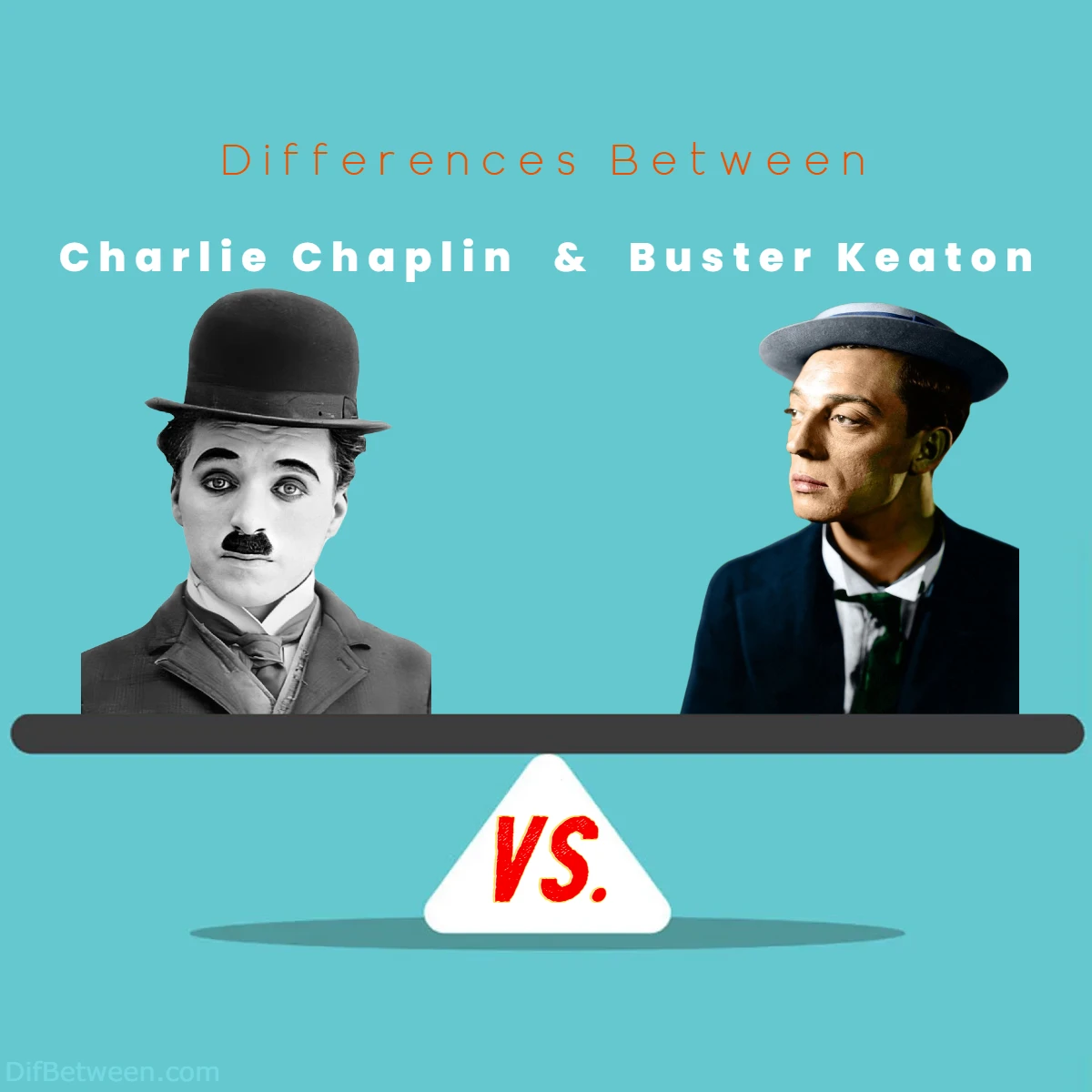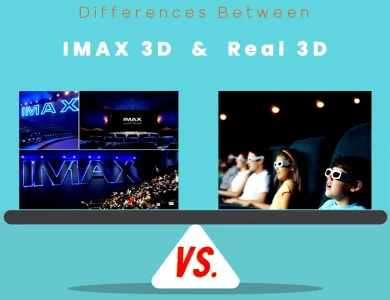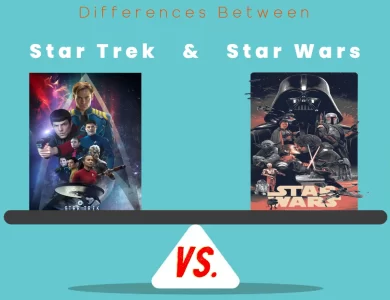
| Comparison Aspect | Charlie Chaplin | Buster Keaton |
|---|---|---|
| Birthdate | April 16, 1889 | October 4, 1895 |
| Birthplace | London, England | Piqua, Kansas |
| Trademark Character | The Tramp | The Great Stone Face |
| Comedic Style | Sentimental comedy with social commentary | Visual wit and physical stunts |
| Physicality | Graceful and balletic movements | Daring stunts and physical athleticism |
| Expression | Expressive facial expressions | Deadpan, stoic expression (“Great Stone Face”) |
| Narrative Approach | Narrative-driven, emotional depth | Technical innovation, visual storytelling |
| Stunt Performance | Moderate stunts, focused on character-driven humor | Elaborate, dangerous stunts with precision |
| Filmmaking Involvement | Involved in writing, directing, and producing | Focused on physical performances, relied on collaborators |
| Themes Explored | Poverty, resilience, societal struggles | Challenges, perseverance, absurdity of life |
| Filmography Examples | “City Lights,” “Modern Times” | “The General,” “Sherlock Jr.” |
| Legacy Recognition | Globally recognized, iconic status | Gained renewed recognition, revered by filmmakers |
| Acclaim and Awards | Honorary Academy Awards, cultural impact | Honorary Academy Award, recognized for unique talents |
| Influence on Modern Comedy | Emotional depth in comedy, nuanced performance | Visual storytelling, daring stunts, technical innovation |
| Influence on Filmmaking | Pioneer of independent filmmaking, co-founded United Artists | Influential in practical effects, stunts, visual storytelling |
| Legacy Impact | Enduring cultural legacy, universal symbol of hope | Revived interest, celebrated as a visual comedy genius |
Imagine yourself transported to the bygone era of the early 20th century, a time when laughter was the universal language that united audiences across the globe. Here, in this enchanting era, the names Charlie Chaplin and Buster Keaton shine brightly. These luminous stars of silent film comedy beckon us to explore the intricate tapestry of their lives, styles, and legacies. From the cobblestone streets of London to the quaint landscapes of Kansas, the stories of their upbringing and entry into the world of entertainment paint a vivid backdrop for the symphony of laughter and marvel that was yet to unfold.
Differences Between Charlie Chaplin and Buster Keaton
The main differences between Charlie Chaplin and Buster Keaton lie in their comedic styles, character personas, and approaches to filmmaking. Charlie Chaplin, known for his iconic Tramp character, mastered the art of sentimental comedy with social commentary, blending humor and emotion in a narrative-driven approach. On the other hand, Buster Keaton, celebrated as “The Great Stone Face,” excelled in visual wit and physical stunts, relying on daring athleticism and technical innovation to create his comedic universe. While Chaplin’s performances emphasized empathy and depth, Keaton’s films showcased intricate physical gags and ingenious use of props. Their legacies, though distinct, continue to shape modern comedy and filmmaking, making them legendary figures in the history of entertainment.
Early Life and Entry into Comedy
Charlie Chaplin: The Tramp with a Heart of Gold
Sir Charles Spencer Chaplin, famously known as Charlie Chaplin, was born on April 16, 1889, in London, England. His childhood was marked by poverty and hardship, which significantly influenced his future comedic style. Chaplin’s introduction to show business came through his parents’ involvement in the theater. He made his stage debut at the tender age of five, and his journey into comedy began.
Chaplin’s iconic character, the Tramp, emerged during his time with the Keystone Film Company. With his bowler hat, cane, and distinctive mustache, the Tramp was a lovable yet poignant figure, representing the resilience of the human spirit in the face of adversity. Chaplin’s early films, such as “The Kid” and “City Lights,” showcased his ability to blend slapstick humor with heartfelt emotion, creating a unique brand of comedy that resonated with audiences worldwide.
Buster Keaton: The Great Stone Face
Joseph Frank Keaton, affectionately known as Buster Keaton, was born on October 4, 1895, in Piqua, Kansas. As the son of vaudeville performers, Keaton was practically born into the world of entertainment. He earned his nickname “Buster” from magician Harry Houdini, who witnessed young Keaton surviving a fall down a flight of stairs unscathed. This incident epitomized Keaton’s legendary physical resilience and became a theme in his later comedic endeavors.
Keaton’s style was characterized by his deadpan expression, earning him the moniker “The Great Stone Face.” His entry into silent film came when he joined forces with Roscoe “Fatty” Arbuckle, a prominent comedian at the time. Keaton’s performances in shorts like “One Week” and “The General” showcased his exceptional athleticism, daring stunts, and innovative use of props, setting him apart as a master of physical comedy.
Comedic Style and Techniques
Charlie Chaplin: The Art of Sentimental Comedy
Chaplin’s comedic style was marked by a profound blend of humor and pathos. His Tramp character, with his tattered clothes and lovable mannerisms, captured the hearts of audiences through his misadventures and heartfelt interactions. Chaplin’s humor often stemmed from his character’s struggles against the constraints of society and his unrelenting optimism in the face of adversity.
One of Chaplin’s trademark techniques was his use of physicality to convey emotion. His balletic movements, precise timing, and intricate gestures added depth to his characters and amplified the emotional impact of his scenes. The Tramp’s interactions with other characters, especially those in positions of authority, led to hilarious power struggles and instances of social commentary.
Chaplin’s films, such as “Modern Times,” allowed him to voice his concerns about the dehumanizing effects of industrialization and technological progress. His ability to seamlessly intertwine laughter with poignant social commentary set him apart as a true comedic auteur.
Buster Keaton: The Art of Visual Wit
Keaton’s approach to comedy was characterized by his unparalleled mastery of visual gags and intricate stunts. Often referred to as the “Clown Prince of Silent Comedy,” Keaton’s deadpan expression served as a counterpoint to the chaos and mayhem that surrounded him. His physical dexterity and fearless approach to stunts set him apart as a true daredevil of the silver screen.
Keaton’s comedy thrived on ingeniously designed scenarios and elaborate set pieces. His background in vaudeville and his family’s experience in stage performance inspired him to create meticulously choreographed routines that relied on split-second timing and precise execution. For instance, in “Sherlock Jr.,” Keaton’s character literally enters a film within a film, leading to a series of mind-bending and hilarious visual tricks.
Unlike Chaplin, Keaton often appeared as a self-reliant hero who faced outrageous challenges with an unwavering resolve. His dedication to performing his own stunts, even in the face of danger, showcased his commitment to his craft. Keaton’s films were a symphony of physical humor, and his inventive use of props and machinery added layers of complexity to his comedic universe.
Legacy and Impact
Charlie Chaplin: The Global Icon of Laughter and Empathy
Charlie Chaplin’s impact on the world of entertainment is immeasurable. His Tramp character became a universal symbol of hope, resilience, and the indomitable human spirit. Chaplin’s ability to elicit both laughter and tears from his audiences solidified his status as a true cinematic pioneer. Even as sound cinema emerged, Chaplin successfully transitioned to talking films, further showcasing his versatility and enduring appeal.
Chaplin’s legacy extended beyond his on-screen presence. He was a visionary filmmaker who wrote, directed, produced, and even composed music for his films. His contributions to the art of filmmaking earned him recognition as one of the most influential figures in cinema history. Even today, his films like “The Gold Rush” and “City Lights” continue to captivate new generations, bridging the gap between eras and proving the timelessness of his comedy.
Buster Keaton: The Unsung Hero of Physical Comedy
Buster Keaton’s influence on comedy and filmmaking is no less profound. While he may not have achieved the same level of widespread recognition as Chaplin, Keaton’s contributions are celebrated by filmmakers, critics, and artists alike. His pioneering use of camera tricks, practical effects, and physical stunts laid the groundwork for future action and comedy films.
Keaton’s legacy continued to evolve over time, with revived interest in his works among cinephiles and scholars. In the late 20th century, his films experienced a resurgence in popularity, garnering the recognition they deserved. Keaton’s impact is evident in the works of contemporary comedians and directors who draw inspiration from his timeless comedic sensibilities.
Cinematic Approaches and Filmmaking Innovations
Charlie Chaplin: Crafting Narratives of the Heart
Charlie Chaplin’s cinematic approach was marked by his meticulous attention to detail and his hands-on involvement in every aspect of filmmaking. His approach was more narrative-driven, focusing on weaving stories that connected with the audience on emotional levels. Chaplin’s films often followed a linear structure, allowing the audience to become deeply invested in the characters and their journeys.
Chaplin’s innovative use of editing and visual storytelling techniques was evident in films like “The Kid.” This film not only showcased his comedic genius but also his ability to craft a heartwarming narrative that explored themes of poverty, family, and friendship. His direction ensured that every scene had a purpose, leading to a cohesive and emotionally resonant experience for the viewers.
Beyond the on-screen performances, Chaplin’s influence extended to film production as well. He was a founding member of United Artists, a studio that allowed filmmakers to retain creative control over their work. This move was revolutionary at the time and contributed to shaping the modern entertainment industry.
Buster Keaton: A Master of Technical Ingenuity
Buster Keaton’s filmmaking approach leaned heavily into technical innovation and creative problem-solving. His films often featured elaborate and meticulously planned physical stunts that required precise timing and execution. Keaton’s dedication to perfection often led him to take significant risks for the sake of capturing the perfect shot.
One of Keaton’s most famous stunts occurred in “Steamboat Bill, Jr.,” where a two-ton facade collapsed around him. The stunt required impeccable timing, and Keaton’s positioning within a specific window of the collapsing structure was accurate down to inches. This level of commitment to achieving the desired visual effect was emblematic of Keaton’s dedication to his craft.
Keaton’s films, such as “The General,” demonstrated his ability to incorporate intricate physical elements into the narrative. The film’s spectacular locomotive chase scene not only showcased Keaton’s audacious stunts but also seamlessly integrated them into a compelling storyline. Keaton’s innovative use of props, machinery, and practical effects set new standards for visual storytelling in cinema.
Reception and Critical Acclaim
Charlie Chaplin: Universally Acclaimed Icon
Charlie Chaplin’s films garnered widespread critical acclaim during his lifetime and continue to receive praise from modern critics. His ability to blend humor and heart resonated with audiences of all ages and backgrounds. His exploration of themes like poverty, class disparity, and the human condition elevated his films beyond mere entertainment, earning them a place in the annals of cinematic history.
Chaplin’s talent was recognized by his peers and the industry at large. He received several honors, including an honorary Academy Award for “The Circus,” and his influence on filmmaking was celebrated with a star on the Hollywood Walk of Fame. Chaplin’s impact extended beyond entertainment, and his work played a role in shaping cultural conversations of his time.
Buster Keaton: From Resurgence to Reverence
While Buster Keaton’s career faced challenges during the transition to sound cinema, his legacy experienced a resurgence decades later. Film enthusiasts and critics revisited his works, recognizing the unparalleled technical achievements and timeless humor present in his films. Keaton’s films began to receive the recognition they deserved as masterpieces of silent comedy.
In 1957, Keaton was awarded an Honorary Academy Award for his “unique talents which brought immortal comedies to the screen.” This acknowledgment from the industry highlighted the lasting impact of his contributions. Today, Keaton’s films are celebrated in film festivals, retrospectives, and academic discussions, solidifying his status as a visionary in the world of visual comedy.
Influence on Modern Comedy and Filmmaking
Charlie Chaplin: Inspiring Compassion and Laughter
Charlie Chaplin’s influence on modern comedy and filmmaking is vast and enduring. His ability to seamlessly intertwine humor with genuine emotion set a precedent for comedy that resonates with depth. Chaplin’s performances continue to serve as a reference for actors and comedians who seek to create well-rounded characters that evoke empathy and laughter simultaneously.
Chaplin’s use of physicality, subtle gestures, and facial expressions has left an indelible mark on the craft of acting. His attention to detail in both comedic and dramatic scenes showcases the power of nuanced performance. Filmmakers and actors still study Chaplin’s work to learn how to create a deep emotional connection with their audiences.
Buster Keaton: Influencing Visual Storytelling
Buster Keaton’s impact on modern comedy and filmmaking is evident in the visual storytelling techniques used in contemporary cinema. Filmmakers draw inspiration from his innovative use of practical effects, physical comedy, and stunts. The tradition of pushing the boundaries of physicality in films owes much to Keaton’s daring feats and technical ingenuity.
Directors such as Jackie Chan, Steven Spielberg, and Quentin Tarantino have cited Keaton’s influence on their work. The legacy of Keaton’s stunts and visual gags can be seen in action-packed sequences and meticulously choreographed set pieces in modern films. His ability to blend slapstick humor with intricate storytelling elements has shaped the way filmmakers approach their craft.
Conclusion: A Dynamic Duo of Laughter and Legacy
In the grand narrative of comedy history, Charlie Chaplin and Buster Keaton stand tall as pioneers, each with their unique imprint on the world of entertainment. Chaplin’s blend of sentimentality and social commentary continues to touch hearts, while Keaton’s masterful physicality and technical brilliance astonish and inspire. These two comedic icons, though distinct in style, share a common legacy: bringing joy, laughter, and innovation to generations of audiences.
FAQs
Charlie Chaplin, born on April 16, 1889, in London, England, was a legendary silent film actor, director, and producer. He is renowned for his iconic character, the Tramp, and his distinctive blend of sentimental comedy with social commentary.
Buster Keaton, born on October 4, 1895, in Piqua, Kansas, was a silent film comedian and actor known for his deadpan expression and incredible physical stunts. His comedic style revolved around visual wit and daring athleticism.
Charlie Chaplin’s trademark character was the Tramp, a lovable and resilient figure who often faced challenges with optimism. Buster Keaton was known for “The Great Stone Face,” his deadpan expression that contrasted with the chaos around him.
Chaplin’s style focused on blending humor with genuine emotion and social commentary. He used physicality and sentimentality to create his comedic narratives. Keaton, on the other hand, excelled in visual gags, intricate stunts, and physical athleticism, often relying on technical innovation.
Chaplin was a pioneering filmmaker who wrote, directed, produced, and even composed music for his films. He co-founded United Artists, which allowed filmmakers to retain creative control. Keaton’s legacy lies in his innovative use of practical effects, stunts, and physical comedy, influencing modern visual storytelling.
Chaplin achieved global recognition during his lifetime and received multiple awards, including honorary Academy Awards. Keaton’s legacy experienced a resurgence in later years, with renewed appreciation for his technical brilliance and influence on comedy.
Chaplin’s legacy can be seen in the emotional depth he brought to comedy, inspiring actors to convey both humor and empathy. Keaton’s influence is evident in visual storytelling and physical comedy, influencing modern filmmakers and comedians alike.
Chaplin’s unique contribution was his ability to blend sentimentality and humor, using physicality to convey deep emotions. Keaton’s contribution lies in his daring stunts and technical innovation, pushing the boundaries of physical comedy.
Chaplin was deeply involved in all aspects of filmmaking, from writing to directing. Keaton focused on physical performances and often collaborated with others for his film projects.
Both Chaplin and Keaton have timeless classics worth exploring. If you enjoy heartfelt narratives, start with Chaplin’s films like “City Lights” and “Modern Times.” For visual wit and physical comedy, dive into Keaton’s works such as “The General” and “Sherlock Jr.”
Read More:
Contents



